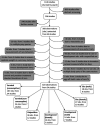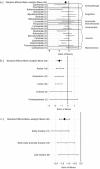Both consumptive and non-consumptive effects of predators impact mosquito populations and have implications for disease transmission
- PMID: 35044908
- PMCID: PMC8769645
- DOI: 10.7554/eLife.71503
Both consumptive and non-consumptive effects of predators impact mosquito populations and have implications for disease transmission
Abstract
Predator-prey interactions influence prey traits through both consumptive and non-consumptive effects, and variation in these traits can shape vector-borne disease dynamics. Meta-analysis methods were employed to generate predation effect sizes by different categories of predators and mosquito prey. This analysis showed that multiple families of aquatic predators are effective in consumptively reducing mosquito survival, and that the survival of Aedes, Anopheles, and Culex mosquitoes is negatively impacted by consumptive effects of predators. Mosquito larval size was found to play a more important role in explaining the heterogeneity of consumptive effects from predators than mosquito genus. Mosquito survival and body size were reduced by non-consumptive effects of predators, but development time was not significantly impacted. In addition, Culex vectors demonstrated predator avoidance behavior during oviposition. The results of this meta-analysis suggest that predators limit disease transmission by reducing both vector survival and vector size, and that associations between drought and human West Nile virus cases could be driven by the vector behavior of predator avoidance during oviposition. These findings are likely to be useful to infectious disease modelers who rely on vector traits as predictors of transmission.
Keywords: disease dynamics; ecology; epidemiology; global health; meta-analysis; mosquito; predation; vector ecology.
Plain language summary
Mosquitoes are often referred to as the deadliest animals on earth because some species spread malaria, West Nile virus or other dangerous diseases when they bite humans and other animals. Adult mosquitoes fly to streams, ponds and other freshwater environments to lay their eggs. When the eggs hatch, the young mosquitoes live in the water until they are ready to grow wings and transform into adults. In the water, the young mosquitoes are particularly vulnerable to being eaten by dragonfly larvae, fish and other predators. When adult females are choosing where to lay their eggs, they can use their sense of smell to detect these predators and attempt to avoid them. Along with eating the mosquitoes, the predators may also reduce mosquito populations in other ways. For example, predators can disrupt feeding among young mosquitoes, which may affect the time that it takes for them to grow into adults or the size of their bodies once they reach the adult stage. Although the impacts of different predators have been tested separately in multiple settings, the overall effects of predators on the ability of mosquitoes to spread diseases to humans remain unclear. To address this question, Russell, Herzog et al. used an approach called meta-analysis on data from previous studies. The analysis found that along with increasing the death rates of mosquitoes, the presence of predators also leads to a reduction in the body size of those mosquitoes that survive, causing them to have shorter lifespans and fewer offspring. Russell, Herzog et al. found that one type of mosquito known as Culex – which carries West Nile virus – avoided laying its eggs near predators. During droughts, increased predation in streams, ponds and other aquatic environments may lead adult female Culex mosquitoes to lay their eggs closer to residential areas with fewer predators. Russell, Herzog et al. propose that this may be one reason why outbreaks of West Nile virus in humans are more likely to occur during droughts. In the future, these findings may help researchers to predict outbreaks of West Nile virus, malaria and other diseases carried by mosquitoes more accurately. Furthermore, the work of Russell, Herzog et al. provides examples of mosquito predators that could be used as biocontrol agents to decrease numbers of mosquitoes in certain regions.
© 2022, Russell et al.
Conflict of interest statement
MR, CH, ZG, CR, FE, ME, TD, NG, SH, AP, AM No competing interests declared
Figures




Similar articles
-
A meta-analysis reveals that dragonflies and damselflies can provide effective biological control of mosquitoes.J Anim Ecol. 2023 Aug;92(8):1589-1600. doi: 10.1111/1365-2656.13965. Epub 2023 Jun 4. J Anim Ecol. 2023. PMID: 37272224 Review.
-
Implications of increasing temperature stress for predatory biocontrol of vector mosquitoes.Parasit Vectors. 2020 Dec 1;13(1):604. doi: 10.1186/s13071-020-04479-3. Parasit Vectors. 2020. PMID: 33261665 Free PMC article.
-
Mesocosm Experiments to Quantify Predation of Mosquito Larvae by Aquatic Predators to Determine Potential of Ecological Control of Malaria Vectors in Ethiopia.Int J Environ Res Public Health. 2021 Jun 27;18(13):6904. doi: 10.3390/ijerph18136904. Int J Environ Res Public Health. 2021. PMID: 34199088 Free PMC article.
-
Vegetation structure drives mosquito community composition in UK's largest managed lowland wetland.Parasit Vectors. 2024 May 6;17(1):201. doi: 10.1186/s13071-024-06280-y. Parasit Vectors. 2024. PMID: 38711091 Free PMC article.
-
Larval predation in malaria vectors and its potential implication in malaria transmission: an overlooked ecosystem service?Parasit Vectors. 2019 May 8;12(1):217. doi: 10.1186/s13071-019-3479-7. Parasit Vectors. 2019. PMID: 31068213 Free PMC article. Review.
Cited by
-
Small mosquitoes: large implications-effects of larval crowding and starvation on locomotor activity, adult biting frequency, and insecticide resistance in two strains of Aedes aegypti.Parasit Vectors. 2025 Jul 1;18(1):244. doi: 10.1186/s13071-025-06886-w. Parasit Vectors. 2025. PMID: 40597431 Free PMC article.
-
Ecological Degradation and the Risk of Mosquito-Borne Disease in the Great Lakes Basin.Ecohealth. 2023 Jun;20(2):150-155. doi: 10.1007/s10393-023-01646-7. Epub 2023 Jul 25. Ecohealth. 2023. PMID: 37488439 Free PMC article. No abstract available.
-
The influence of oviposition status on measures of transmission potential in malaria-infected mosquitoes depends on sugar availability.Parasit Vectors. 2024 May 23;17(1):236. doi: 10.1186/s13071-024-06317-2. Parasit Vectors. 2024. PMID: 38783366 Free PMC article.
-
Interaction of predatory macroinvertebrate communities with malaria vectors in aquatic habitats of three climatic zones in Burkina Faso.Parasit Vectors. 2025 Apr 27;18(1):158. doi: 10.1186/s13071-025-06794-z. Parasit Vectors. 2025. PMID: 40289119 Free PMC article.
-
Consumptive and Non-Consumptive Uses of Water Beetles (Aquatic coleopterans) in Sub-Saharan Traditional Rituals.Insects. 2023 Sep 29;14(10):795. doi: 10.3390/insects14100795. Insects. 2023. PMID: 37887807 Free PMC article.
References
-
- Albright TP, Pidgeon AM, Rittenhouse CD, Clayton MK, Flather CH, Culbert PD, Wardlow BD, Radeloff VC. Effects of drought on avian community structure. Global Change Biology. 2009;16:2158–2170. doi: 10.1111/j.1365-2486.2009.02120.x. - DOI
-
- Alcalay Y, Tsurim I, Ovadia O. Female mosquitoes disperse further when they develop under predation risk. Behavioral Ecology. 2018;29:1402–1408. doi: 10.1093/beheco/ary113. - DOI
-
- Anderson TR. Chapter 6: Foraging Behavior and Food. Biology of the Ubiquitous House Sparrow: From Genes to Populations. New York: Oxford University Press; 2006a. - DOI
Publication types
MeSH terms
Associated data
Grants and funding
LinkOut - more resources
Full Text Sources
Medical

